Silver-Nanowire-Based Localized-Surface-Plasmon-Assisted Transparent Conducting Electrode for High-Efficiency Light-Emitting Diode
Abstract
:1. Introduction
2. Experimental Section
3. Results and Discussion
4. Conclusions
Author Contributions
Funding
Institutional Review Board Statement
Informed Consent Statement
Data Availability Statement
Conflicts of Interest
References
- Sharma, S.; Shriwastava, S.; Kumar, S.; Bhatt, K.; Charu Tripathi, C. Alternative transparent conducting electrode materials for flexible optoelectronic devices. Opt. Rev. 2018, 26, 223. [Google Scholar] [CrossRef]
- Kuo, C.; Chang, S.J.; Su, Y.K.; Chuang, R.; Chang, C.; Wu, L.; Lai, W.; Chen, J.F.; Sheu, J.; Lo, H. Nitride-based near-ultraviolet LEDs with an ITO transparent contact. Mater. Sci. Eng. B 2004, 106, 69–72. [Google Scholar] [CrossRef]
- Kim, J.Y.; Jeon, J.H.; Kwon, M.K. Indium tin oxide-free transparent conductive electrode for GaN-based ultraviolet light-emitting diodes. ACS Appl. Mater. Inter. 2015, 7, 7945–7950. [Google Scholar] [CrossRef]
- Lee, K.; Shin, J.W.; Park, J.H.; Lee, J.; Joo, C.W.; Lee, J.I.; Cho, D.H.; Lim, J.T.; Oh, M.C.; Ju, B.K. A light scattering layer for internal light extraction of organic light-emitting diodes based on silver nanowires. ACS Appl. Mater. Inter. 2016, 8, 17409–17415. [Google Scholar] [CrossRef]
- Guo, H.; Lin, N.; Chen, Y.; Wang, Z.; Xie, Q.; Zheng, T.; Gao, N.; Li, S.; Kang, J.; Cai, D. Copper nanowires as fully transparent conductive electrodes. Sci. Rep. 2013, 3, 2323. [Google Scholar] [CrossRef] [PubMed] [Green Version]
- Jo, G.; Choe, M.; Cho, C.Y.; Kim, J.H.; Park, W.; Lee, S.; Hong, W.K.; Kim, T.W.; Park, S.J.; Hong, B.H. Large-scale patterned multi-layer graphene films as transparent conducting electrodes for GaN light-emitting diodes. Nanotechnology 2010, 21, 175201. [Google Scholar] [CrossRef] [PubMed] [Green Version]
- Seo, T.H.; Kim, B.K.; Shin, G.; Lee, C.; Kim, M.J.; Kim, H.; Suh, E.K. Graphene-silver nanowire hybrid structure as a transparent and current spreading electrode in ultraviolet light emitting diodes. Appl. Phys. Lett. 2013, 103, 51105. [Google Scholar]
- Jeong, G.J.; Lee, J.H.; Han, S.H.; Jin, W.Y.; Kang, J.W.; Lee, S.N. Silver nanowires for transparent conductive electrode to GaN-based light-emitting diodes. Appl. Phys. Lett. 2015, 106, 31118. [Google Scholar] [CrossRef]
- Zhu, R.; Chung, C.H.; Cha, K.C.; Yang, W.; Zheng, Y.B.; Zhou, H.; Song, T.B.; Chen, C.C.; Weiss, P.S.; Li, G. Fused silver nanowires with metal oxide nanoparticles and organic polymers for highly transparent conductors. ACS Nano 2011, 5, 9877–9882. [Google Scholar] [CrossRef] [PubMed]
- Yu, Z.; Zhang, Q.; Li, L.; Chen, Q.; Niu, X.; Liu, J.; Pei, Q. Highly flexible silver nanowire electrodes for shape-memory polymer light-emitting diodes. Adv. Mater. 2011, 23, 664–668. [Google Scholar] [CrossRef]
- Oh, M.; Jin, W.Y.; Jeong, H.J.; Jeong, M.S.; Kang, J.W.; Kim, H. Silver nanowire transparent conductive electrodes for high-efficiency III-nitride light-emitting diodes. Sci. Rep. 2015, 5, 13483. [Google Scholar] [CrossRef] [Green Version]
- Park, J.S.; Kim, J.H.; Kim, J.Y.; Kim, D.H.; Na, J.Y.; Kim, S.K.; Kang, D.; Seong, T.Y. Formation of an indium tin oxide nanodot/Ag nanowire electrode as a current spreader for near ultraviolet AlGaN-based light-emitting diodes. Nanotechnology 2016, 28, 45205. [Google Scholar] [CrossRef]
- Song, W.; Fan, X.; Xu, B.; Yan, F.; Cui, H.; Wei, Q.; Peng, R.; Hong, L.; Huang, J.; Ge, Z. All-Solution-Processed Metal-Oxide-Free Flexible Organic Solar Cells with Over 10% Efficiency. Adv. Mater. 2018, 26, 1800075. [Google Scholar] [CrossRef]
- Xu, X.; Lin, S.; Li, Q.; Zhang, Z.; Lvanov, I.N.; Li, Y.; Wang, W.; Gu, B.; Zhang, Z.; Hsuech, C.; et al. Optical Control of Fluorescence through Plasmonic Eigenmode Extinction. Sci. Rep. 2015, 5, 1. [Google Scholar] [CrossRef] [PubMed] [Green Version]
- Kim, J.Y.; Na, S.I.; Ha, G.Y.; Kwon, M.K.; Park, I.K.; Lim, J.H.; Park, S.J.; Kim, M.H.; Choi, D.; Min, K. Thermally stable and highly reflective AgAl alloy for enhancing light extraction efficiency in GaN light-emitting diodes. Appl. Phys. Lett. 2006, 88, 43507. [Google Scholar] [CrossRef]
- Kim, J.Y.; Cho, Y.H.; Chung, T.H.; Jang, Y.J.; Kim, H.; Bang, S.; Leec, A.; Jeong, M.S.; Ryou, J.H.; Kwon, M.K. Localized surface plasmon-enhanced transparent conducting electrode for high-efficiency light emitting diode. Mater. Lett. 2020, 271, 127790. [Google Scholar] [CrossRef]
- Kwon, M.K.; Kim, J.Y.; Kim, B.H.; Park, I.K.; Cho, C.Y.; Byeon, C.C.; Park, S.J. Surface-plasmon-enhanced light-emitting diodes. Adv. Mater. 2008, 20, 1253–1257. [Google Scholar] [CrossRef]
- Okamoto, K.; Niki, I.; Shvartser, A.; Narukawa, Y.; Mukai, T.; Scherer, A. Surface-plasmon-enhanced light emitters based on InGaN quantum wells. Nat. Mater. 2004, 3, 601–605. [Google Scholar] [CrossRef]
- Cho, C.Y.; Hong, S.H.; Park, S.J. Improvement of optical and electrical properties of indium tin oxide layer of GaN-based light-emitting diode by surface plasmon in silver nanoparticles. Thin Sol. Film. 2015, 590, 76–79. [Google Scholar] [CrossRef]
- Chuang, S.H.; Tsung, C.S.; Chen, C.H.; Ou, S.L.; Horng, R.H.; Lin, C.Y.; Wuu, D.S. Transparent conductive oxide films embedded with plasmonic nanostructure for light-emitting diode applications. ACS Appl. Mater. Inter. 2015, 7, 2546–2553. [Google Scholar] [CrossRef]
- Hu, L.; Kim, H.S.; Lee, J.Y.; Peumans, P.; Cui, Y. Scalable coating and properties of transparent, flexible, silver nanowire electrodes. ACS Nano 2010, 4, 2955–2963. [Google Scholar] [CrossRef]
- Kapoor, S. Preparation, Characterization, and Surface Modification of Silver Particles. Langmuir 1998, 14, 1021. [Google Scholar] [CrossRef]
- Biteen, J.S.; Lewis, N.S.; Atwater, H.A.; Mertens, H.; Polman, A. Spectral tuning of plasmon-enhanced silicon quantum dot luminescence. Appl. Phys. Lett. 2006, 88, 131109. [Google Scholar] [CrossRef] [Green Version]
- Gao, X.; Wang, S.; Li, W.J.; Zheng, Y.; Zhang, R.; Zhou, P.; Yang, Y.; Chen, L. Study of structure and optical properties of silver oxide films by ellipsometry, XRD and XPS methods. Thin Sol. Film. 2004, 455, 438. [Google Scholar] [CrossRef]
- Singh, D.; Dasgupta, A.; Aswathy, V.; Tripathi, R.P.; Kumar, G.P. Directional out-coupling of light from a plasmonic nanowire-nanoparticle junction. Opt. Lett. 2015, 40, 1006–1009. [Google Scholar] [CrossRef] [PubMed] [Green Version]
- Song, M.; Bouhelier, A.; Bramant, P.; Sharma, J.; Dujardin, E.; Zhang, D.; Colas-des-Francs, G. Imaging Symmetry-Selected Corner Plasmon Modes in Penta-Twinned Crystalline Ag Nanowires. ACS Nano 2011, 5, 5874. [Google Scholar] [CrossRef] [PubMed]
- Lu, T.; Ma, Z.; Du, C.; Fang, Y.; Wu, H.; Jiang, Y.; Wnag, L.; Dai, L.; Jia, H.; Liu, W. Temperature-dependent photoluminescence in light-emitting diodes. Sci. Rep. 2014, 4, 6131. [Google Scholar] [CrossRef] [PubMed] [Green Version]
- Nami, M. Feezell, D. Optical properties of Ag-coated GaN/InGaN axial and core-shell nanowire light-emitting diodes. J. Opt. 2015, 17, 25004. [Google Scholar] [CrossRef] [Green Version]
- Zhu, S.; Yu, Z.; Liu, L.; Yang, C.; Cao, H.; Xi, X.; Zhao, L. Enhancing the spontaneous emission rate by modulating carrier distribution in GaN-based surface plasmon light-emitting diodes. Opt. Expr. 2017, 25, 9617. [Google Scholar] [CrossRef]
- Oh, M.; Kim, H. High-efficiency GaN-based light-emitting diodes fabricated with identical Ag contact formed on both n- and p-layers. Opt. Expr. 2013, 21, 20857. [Google Scholar] [CrossRef]
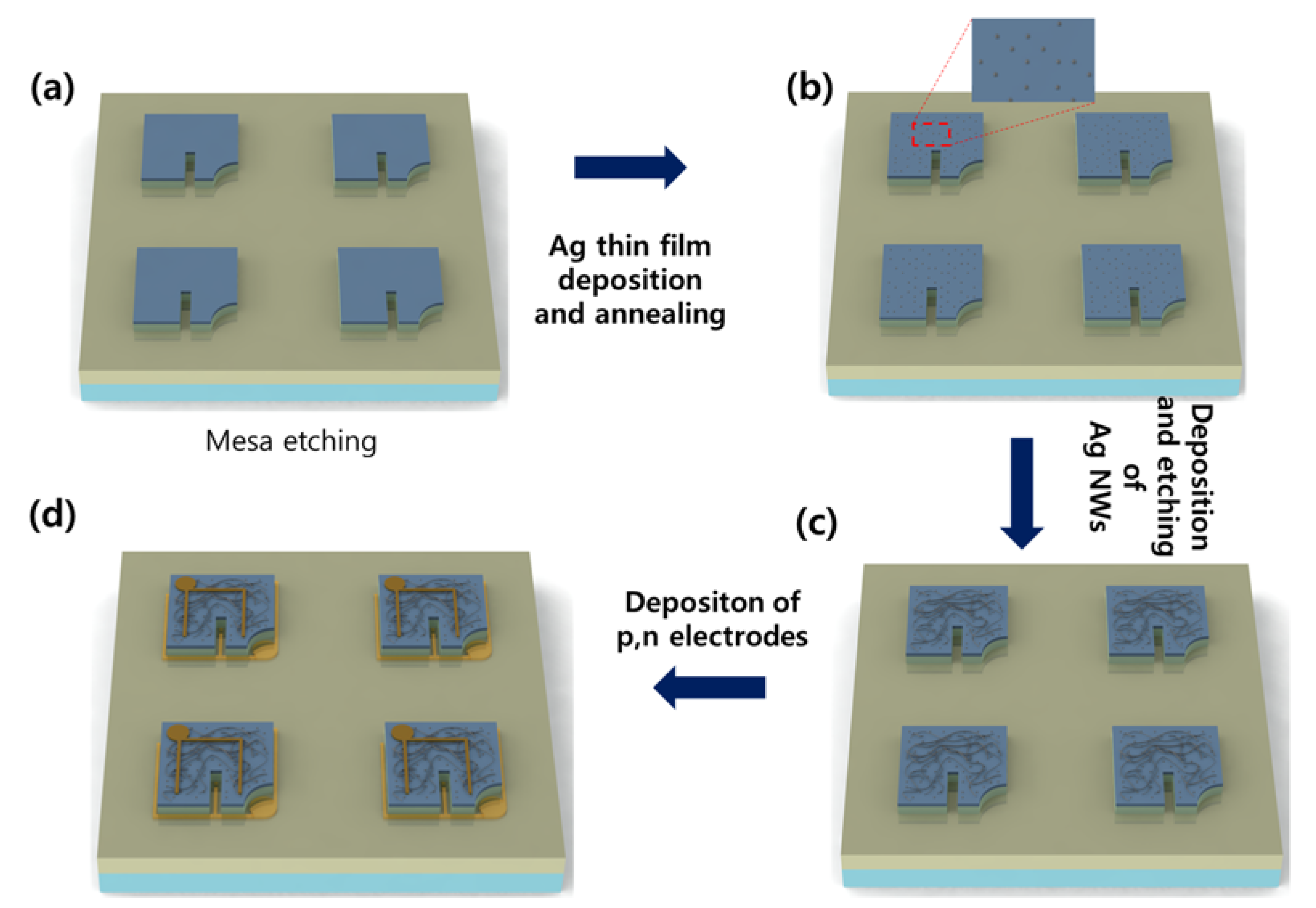
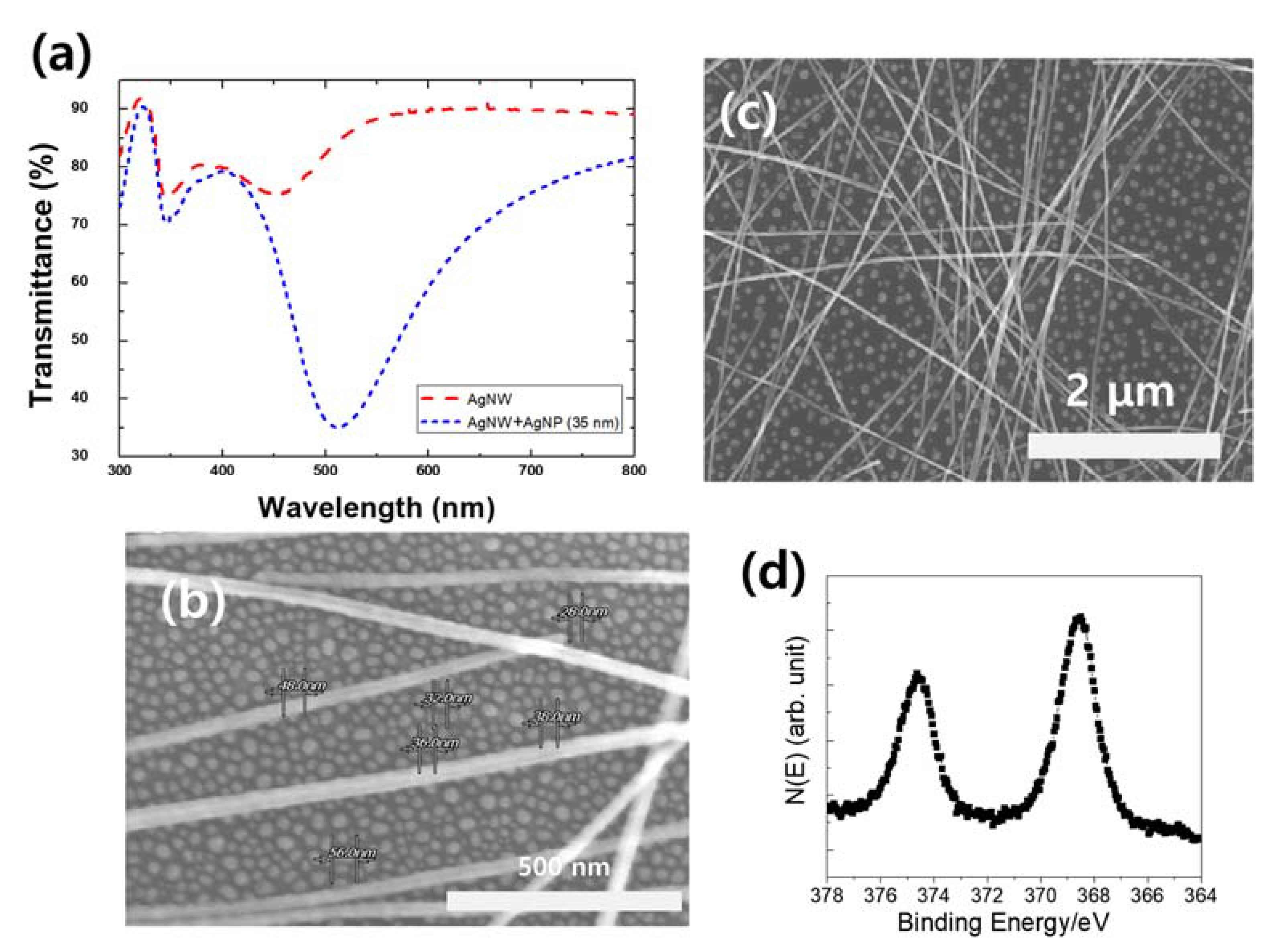
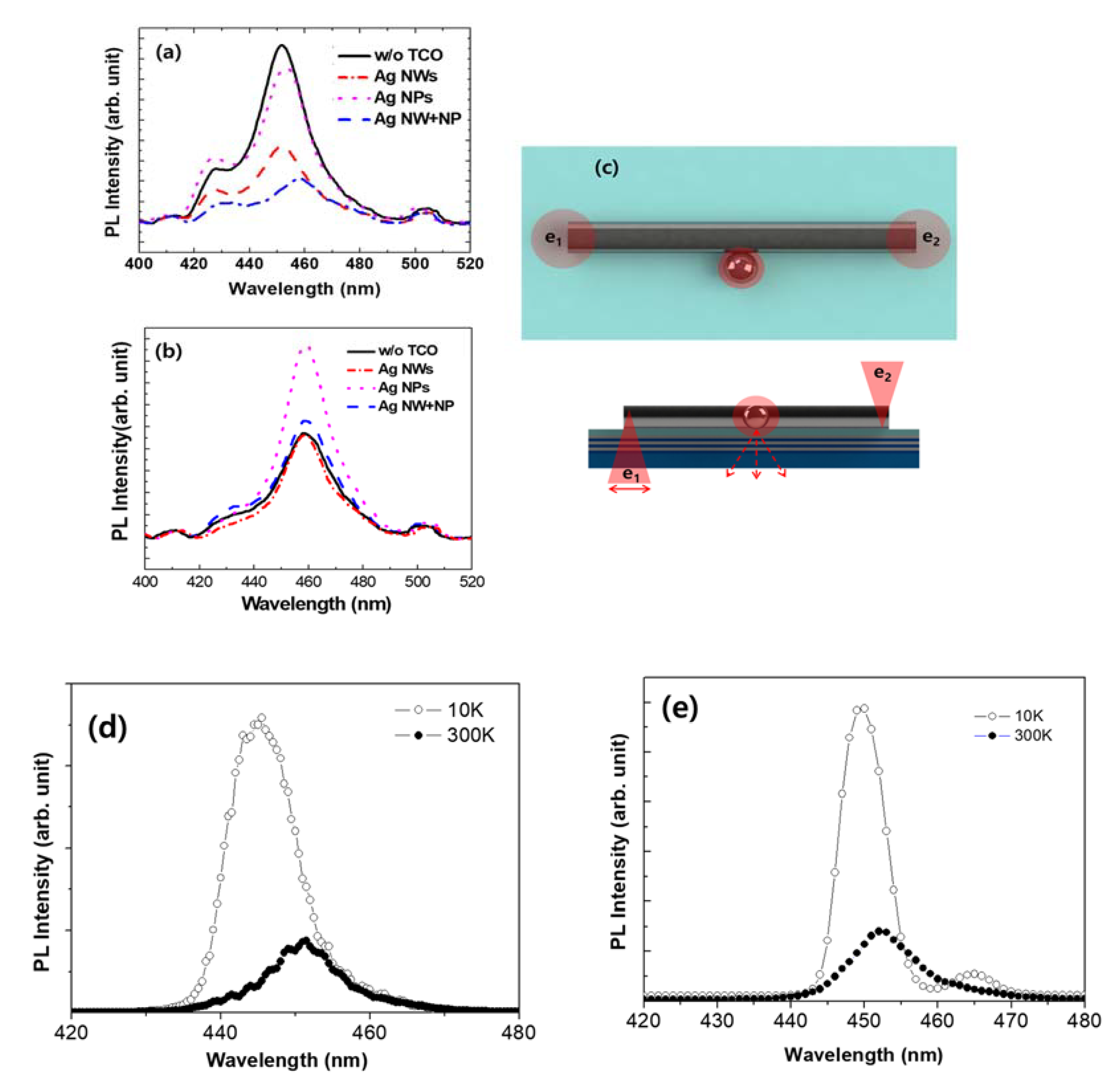
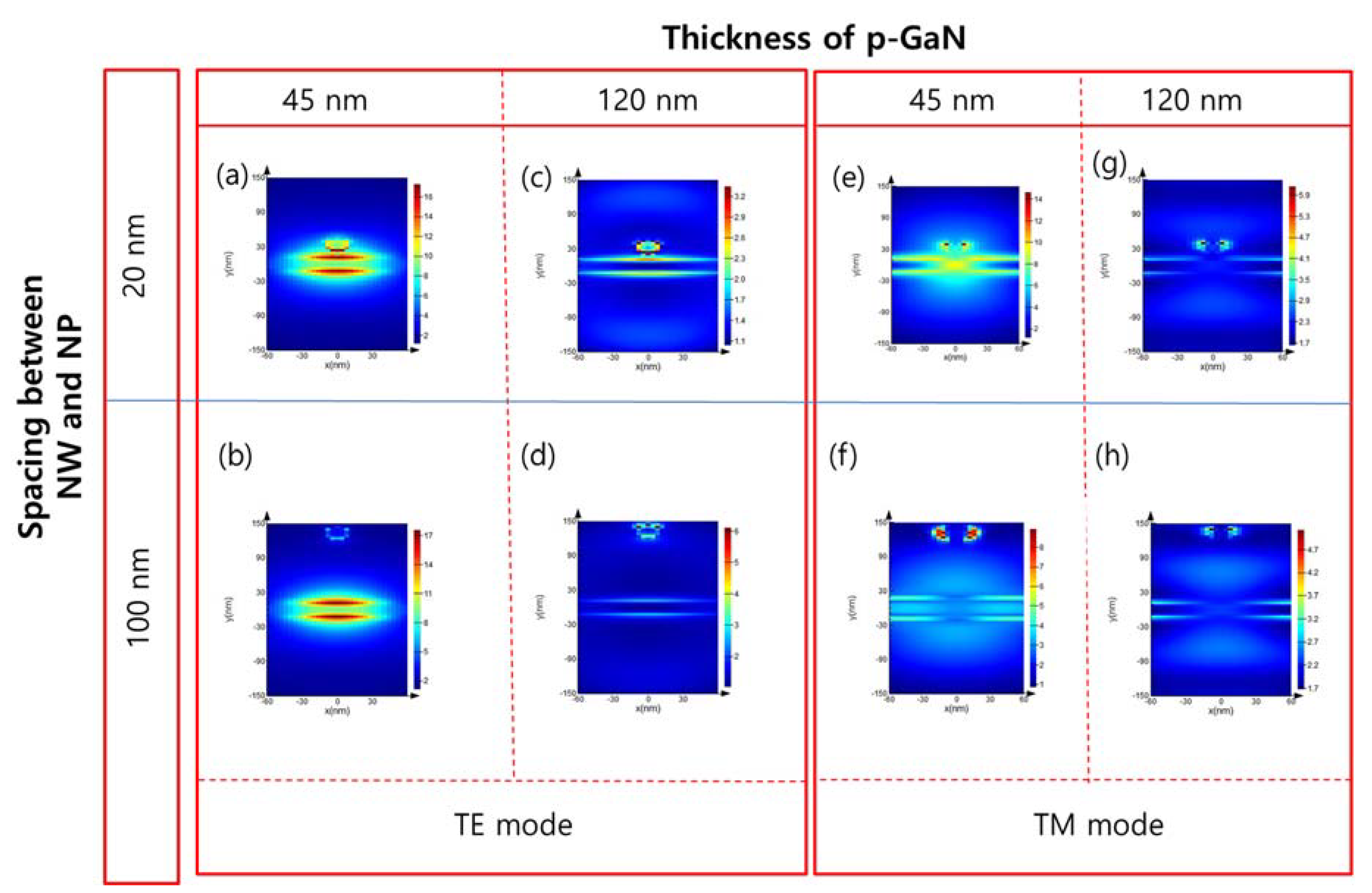
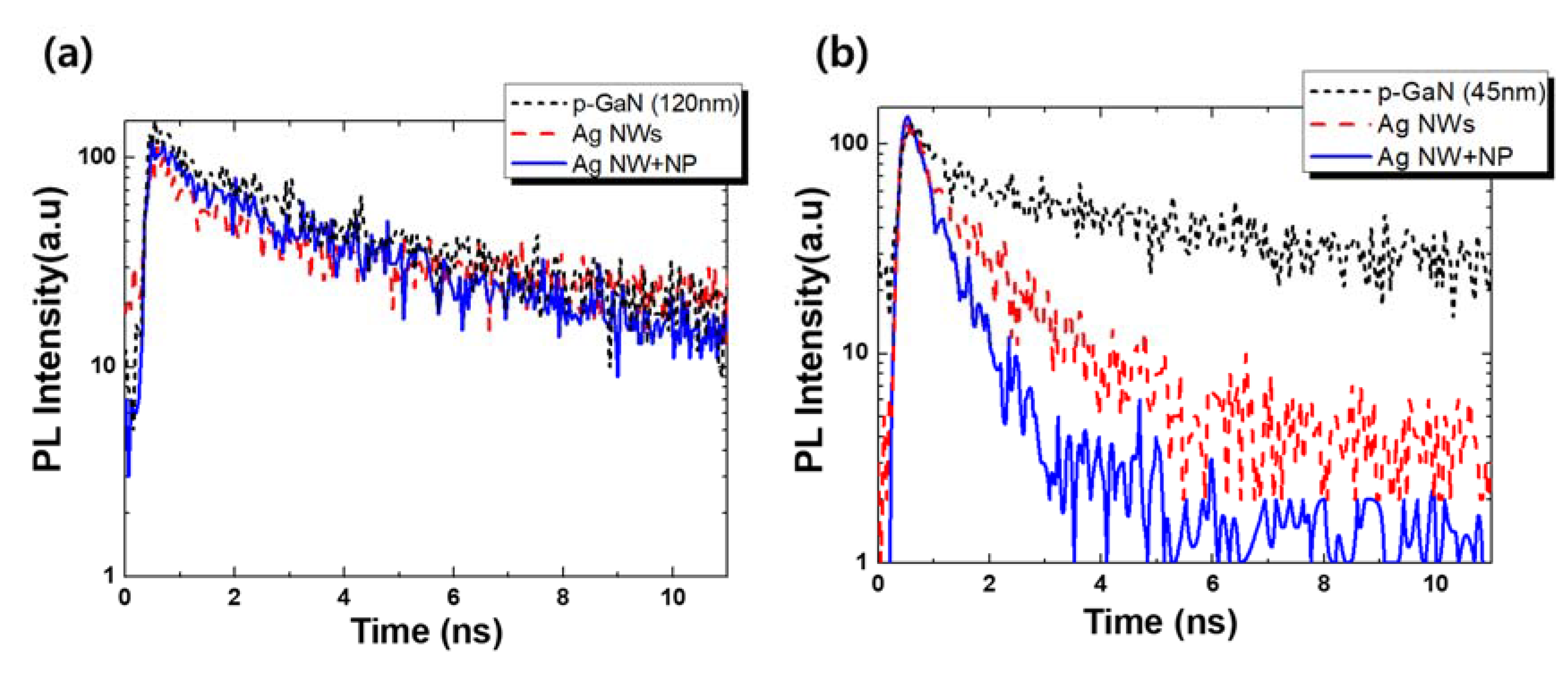
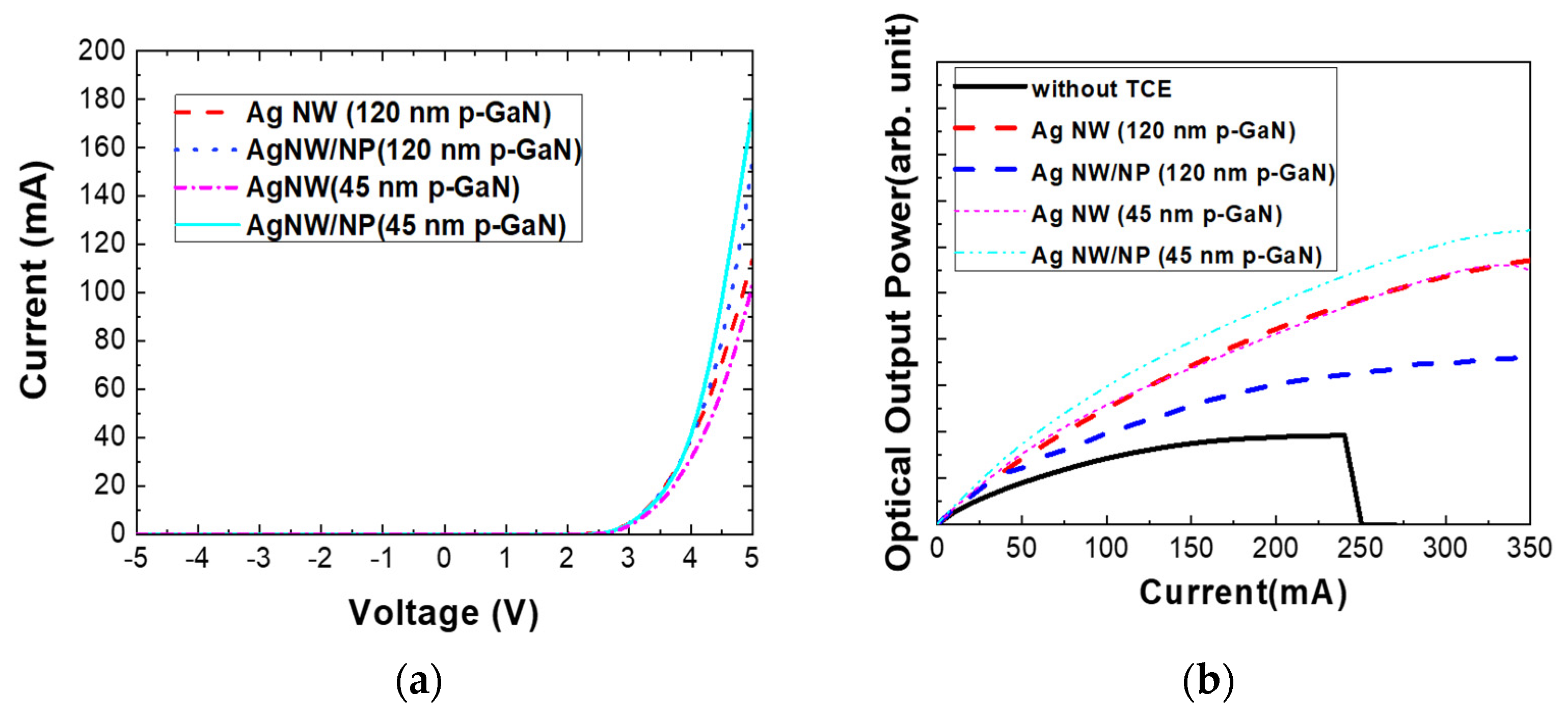
Publisher’s Note: MDPI stays neutral with regard to jurisdictional claims in published maps and institutional affiliations. |
© 2021 by the authors. Licensee MDPI, Basel, Switzerland. This article is an open access article distributed under the terms and conditions of the Creative Commons Attribution (CC BY) license (https://creativecommons.org/licenses/by/4.0/).
Share and Cite
Kim, J.-Y.; Oh, G.-G.; Kim, E.; Kim, H.-S.; Hong, G.; Ryou, J.-H.; Kwon, M.-K. Silver-Nanowire-Based Localized-Surface-Plasmon-Assisted Transparent Conducting Electrode for High-Efficiency Light-Emitting Diode. Appl. Sci. 2021, 11, 7747. https://doi.org/10.3390/app11167747
Kim J-Y, Oh G-G, Kim E, Kim H-S, Hong G, Ryou J-H, Kwon M-K. Silver-Nanowire-Based Localized-Surface-Plasmon-Assisted Transparent Conducting Electrode for High-Efficiency Light-Emitting Diode. Applied Sciences. 2021; 11(16):7747. https://doi.org/10.3390/app11167747
Chicago/Turabian StyleKim, Ja-Yeon, Gwang-Geun Oh, Eunjin Kim, Hyeon-Seung Kim, Gwangsik Hong, Jae-Hyun Ryou, and Min-Ki Kwon. 2021. "Silver-Nanowire-Based Localized-Surface-Plasmon-Assisted Transparent Conducting Electrode for High-Efficiency Light-Emitting Diode" Applied Sciences 11, no. 16: 7747. https://doi.org/10.3390/app11167747
APA StyleKim, J.-Y., Oh, G.-G., Kim, E., Kim, H.-S., Hong, G., Ryou, J.-H., & Kwon, M.-K. (2021). Silver-Nanowire-Based Localized-Surface-Plasmon-Assisted Transparent Conducting Electrode for High-Efficiency Light-Emitting Diode. Applied Sciences, 11(16), 7747. https://doi.org/10.3390/app11167747






